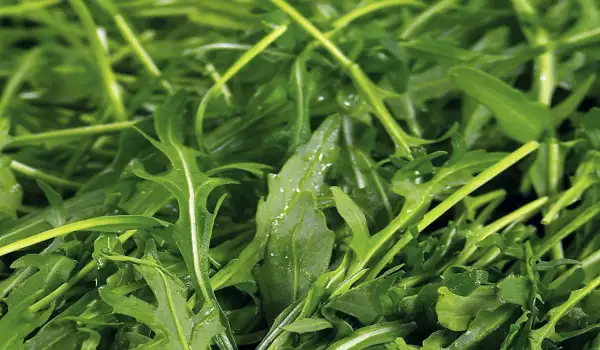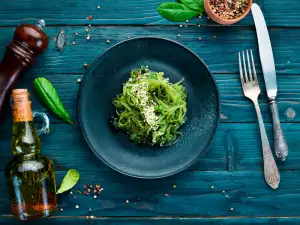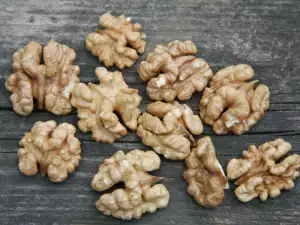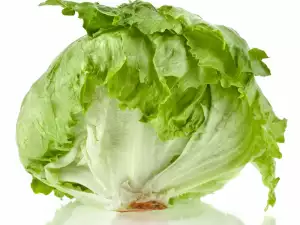Arugula (Eruca sativa and Brassica eruca) is an annual plant of the Brassicaceae family, which is gaining in popularity as an ingredient in vegetable salads and has been used for many years.
The plant is common in the Middle East, mainly in Turkey, Jordan and Morocco. Grows in Central and Eastern Europe, North, Central, South West, East and Central Asia, North Africa, Australia, where imported by settlers. It occurs as a weed in wheat crops, and sometimes grows near railway lines.
Arugula was known in ancient Rome, where it is used as a spice. Even then, the seeds of the plant have been considered an aphrodisiac. In those years, arugula was mixed with grated orchid bulbs and parsnips, pine nuts and pistachios.

Arugula has a kinship with mustard. The plant reaches a height of 24" (60 cm), the leaves are relatively thick, hairy (there are also "hairless" variants), with a specific flavor. Lower leaves are feather- like and jerky. The colors of arugula are yellow or white and bloom from May to July, bears fruit in July and August.
Composition of arugula
Arugula has a rich composition of nutrients. It contains an enviable amount of essential oils, carotene, vitamin C, vitamins of the B group and minerals. Arugula is rich not only oils but also organic acids, vitamins, - A, C, and K, and minerals - calcium, potassium, magnesium, iron, phosphorus and sodium. Arugula is in the top 10 of green leafy vegetables containing the most provitamin A, also known as the vitamin of beauty.
These small and cute and leaves are very rich in antioxidants, important for pregnancy folic acid and vitamin B1, which helps to cope with stress.
Pantothenic acid in arugula improves the metabolism.
The minerals of the greatest amount are potassium and iron. An interesting fact is that, unlike most green leafy vegetables, arugula has essential fatty acids Omega-3, which are more commonly found in seeds and nuts.
Selecting and storing arugula
Like most leafy green vegetables, the arugula you choose must be fresh and delicate, with brittle leaves, which guarantees us the most of the nutrients are in it. Fresh arugula leaves can be kept in a bag in the refrigerator for several days.
Culinary use of arugula
Arugula culinary uses require the leaves, and the younger and fresher they are, the better. Have a slightly pungent flavor reminiscent of the taste of vegetables from the same cruciferous family - Brassicaceae, such as turnips, headed cabbage and horseradish and has and flavor characteristic of pecans. Usually older arugula leaves are tough and have the characteristic flair.
Arugula is consumed fresh, as it makes salads or is added as part of a salad. Classic recipe for rocket salad needs balsamic vinegar, olive oil and thinly sliced parmesan. Small leaves are added to salads whole and larger ones are torn, but not cut with a knife. Like most leafy greens, fresh arugula vitamins are killed by touching the blade.
Arugula is very popular in Mediterranean cuisine, especially in Italy. They are loved for the preparation of certain types of risotto and sauces for pasta. Arugula is well combined with the typical Mediterranean products such as capers and pine nuts.
Light hotness in the leaf is ideal for seafood and fish. Used instead of basil for making pesto. When canning vegetables, they often remove moisture oil from the seeds of arugula.

Arugula Paste
Arugula - 1 bunch
pumpkin seeds – 3 1/3 tbsp (50 g)
cream - 4/5 cup (200 g) sour
salt
pepper
lemon juice
Method of preparation: clean arugula and remove the stems. Blend it with pumpkin seeds. Stir in sour cream previously broken until a smooth mixture and then season with salt, pepper and lemon juice. Serve arugula paste on grilled bread or anything that seems appropriate.
Benefits of Arugula
Arugula is full of aphrodisiacs - substances that evoke sexual appetite. Even the Romans have felt this magical property of arugula and even today it has earned the nickname natural Viagra. Potassium in arugula supports the work of the heart and has a diuretic effect, but because the iron, it can easily cope with spring fatigue.

Salad with arugula
It is proved that arugula normalizes metabolism, increases hemoglobin and positively influences obesity. Provitamin A in Arugula, also known as the vitamin of beauty ensures a fresh complexion, shiny hair, strengthens nails, smoothes wrinkles.
To arugula are attributed strong therapeutic properties, including preventing the formation of tumors. It significantly reduces the secretion of gastric acid, which contributes to the formation of ulcers and gastroenterologists have reached to the conclusion that arugula has antioxidative and anti- seretion effect on the ulcers and prevents the formation of ulcers of the stomach.
Arugula was usedas an expectorant in chronic bronchitis and to treat scurvy. At present, scientists continue to discover more and more new useful properties of arugula. There is evidence that the drug affects the successful reduction of blood glucose in the body.
Fresh arugula leaves are used as an adjuvant in the treatment of struma, anemia, thyroid diseases, in inflammatory diseases of the urinary tract, skin rash, etc.




















Comments